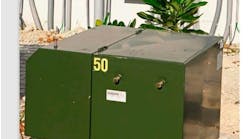When designing future projects to meet the requirements of the 2020 Edition of the National Electrical Code (NEC), chances are your electrical rooms, power distribution centers, and substations will grow a bit larger. Why? There was one simple sentence added to Sec. 110.26(C)(2), which states: “…Open equipment doors shall not impede the entry to or egress from the working space…”.
The electrical equipment being referred to in this Section specifically includes any piece of electrical equipment containing “overcurrent devices, switching devices, or control devices” if the equipment is either: (1) rated 1,200A or more and over 1.8 m (6 ft) wide, or (2) the service disconnecting means installed in accordance with Sec. 230.71 where the combined ampere rating is 1,200A or more and over 1.8 m (6 ft) wide.
Even though this requirement was added to Sec. 110.26 (1,000V or less) by way of Sec. 110.30, this change will apply to ALL large electrical equipment meeting the above-mentioned criteria, regardless of the voltage level. This change will most likely result in a substantial increase in the size of most rooms containing large motor control centers or switchgear.
For many years, most Authorities Having Jurisdiction (AHJs) have categorized most cases where there are two pieces of opposing equipment fronts to be a “Condition 3” situation [either NEC Table 110.26(A)(1) or Table 110.34(A)]. It will be interesting to see if AHJs will now require the requisite 24 in. egress space where opposing equipment doors can be fully opened simultaneously. This condition could occur either where the open doors are directly across from one another or at opposite ends of the working space. If the new requirement gets applied in this manner, the electrical room size could increase even more.
This rule change is new to the 2020 NEC, but it’s just a matter of time before it is incorporated into OSHA 29 CFR Part 1910, Subpart S. However, in the United States and its territories, OSHA inspectors already actively enforce the NEC as part of worker safety required by the General Duty Clause 5(a)(1), which requires employers to provide safe working environments and conditions. So, the inevitable inclusion as part of 29 CFR Part 1910 is somewhat irrelevant.
Eddie Guidry is a senior fellow with Fluor Enterprises, Inc., Sugar Land, Texas.
![Typical electrical room with large electrical equipment with opposing fronts [NEC Tables 110.26(A)(1) or Table 110.34(A), Condition 3]. Typical electrical room with large electrical equipment with opposing fronts [NEC Tables 110.26(A)(1) or Table 110.34(A), Condition 3].](https://img.ecmweb.com/files/base/ebm/ecmweb/image/2019/12/ElectricalRooms.5df7f360f3dd2.png?auto=format,compress&fit=crop&q=45&h=139&height=139&w=250&width=250)


